MCQ: Introduction to Graphs | Mathematics (Maths) Class 8 PDF Download
Q1: A ________ is a bar graph that shows data in intervals.
(a) Bar-graph
(b) Pie-chart
(c) Histograph
(d) Line Graph
 View Answer
View Answer 
Ans: (a)
A histogram is an accurate graphical representation of the distribution of numerical data. It is usually used to represent groups or classes of data.
Q2: A graph that displays data that changes continuously over periods of time is called:
(a) Bar-graph
(b) Pie-chart
(c) Histograph
(d) Line Graph
 View Answer
View Answer 
Ans: (d)
A line graph displays data that change continuously over periods of time.
Q3: A-line graph which is a whole unbroken line is called a:
(a) Linear graph
(b) Pie-chart
(c) Histograph
(d) Bar-graph
 View Answer
View Answer 
Ans: (a)
A line graph consists of bits of line segments joined consecutively. The graph which has a whole unbroken line called linear graphs.
Q4: Which point lies on the y-axis?
(a) (4,0)
(b) (0,4)
(c) (0,−8)
(d) both b and c
 View Answer
View Answer 
Ans: (d)
We know, any point which lies on the y-axis will be of the form (0,y), where y is any real number. Here, the points (0,4) and (0,−8) are of the form (0,y), where y=4 and −8, respectively.
Q5: Point (4,0) lies on
(a) x-axis
(b) y-axis
(c) origin
(d) None of the above
 View Answer
View Answer 
Ans: (a)
XO is a positive x-axis, so (4,0) lies on it.
Q6: The distance of the point (−2,−2) from the origin is
(a) √ 8 units
(b) 2√2 units
(c) both A & B
(d) √2 units
 View Answer
View Answer 
Ans: (b)
Distance between two points (x1, y1) and (x2, y2) can be calculated using the formula.
Distance between (−2,−2) and (0,0) =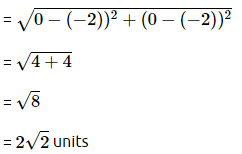
Q7: The point (-2,-2) is:
(a) near to x-axis
(b) near to y-axis
(c) near to origin
(d) Equidistant from x-axis and y-axis.
 View Answer
View Answer 
Ans: (d)
given that,
x - coordinate = 2
y - coordinate = 2
then,
Distance of x - coordinate from origin = 2
Distance of y - coordinate from origin = 2
therefore, we can conclude that,
Point (2,2) are equidistant from x - axis and y - axis.
Q8: The point (-2, 5) is nearer to:
(a) x-axis
(b) y-axis
(c) origin
(d) None of the above
 View Answer
View Answer 
Ans: (b)
Since the given point (-2,5) is the nearest to the y - axis. So, (- 2,5) will be perpendicular on y-axis. Hence, the required point on y-axis be (0, 5).
Q9: The point (-2, 5) is nearer to:
(a) x-axis
(b) y-axis
(c) Both axis
(d) None of the above.
 View Answer
View Answer 
Ans: (c)
We know, the coordinates of the point of intersection of the x-axis and y-axis is called the origin. Also, the two axes intersect each other when x=0 and y=0. That is, the coordinates of the origin is (0,0). Hence, the given point is the origin. Then, the origin lies in both the axes x and y.
Q10: Observe the diagram, given below and find the correct answer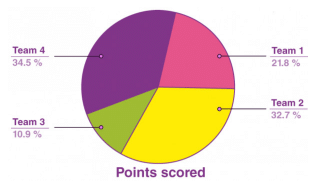 Which team has the highest score?
Which team has the highest score?
(a) Team 1
(b) Team 2
(c) Team 3
(d) Team 4
 View Answer
View Answer 
Ans: (c)
Team 4 has the highest score with 34.5%
Q11: Below is the data of the number of men and women in a village for different years. Now based on this data answer the question 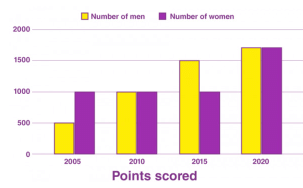 How many men were there in the village in 2010?
How many men were there in the village in 2010?
(a) 500
(b) 1000
(c) 1500
(d) 2000
 View Answer
View Answer 
Ans: (b)
There were 1000 men in the year 2010 in the village.
Q12: Observe the diagram, given below and find the correct answer 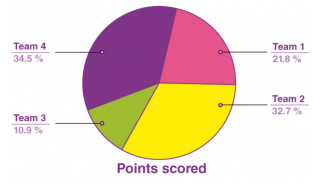 Which team has the second-highest score?
Which team has the second-highest score?
(a) Team 1
(b) Team 2
(c) Team 3
(d) Team 4
 View Answer
View Answer 
Ans: (b)
Team 2 has the second-highest score, equal to 32.7%.
Q13: Below is the data of the number of men and women in a village for different years. Now based on this data answer the question 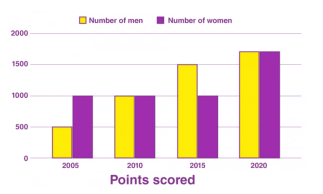 When is the population of men, the minimum?
When is the population of men, the minimum?
(a) 2005
(b) 2010
(c) 2015
(d) 2020
 View Answer
View Answer 
Ans: (a)
In 2005, there were only 500 men in the village.
Q14: In the x-y coordinate system point (-3, -3) lies in which quadrant?
(a) III quadrant
(b) II quadrant
(c) I quadrant
(d) IV quadrant
 View Answer
View Answer 
Ans: (a)
The terminal arm passes through (−3,−3). The point is of the form, (x,y). Here, x is negative and y is negative, which lies in III quadrant.
Q15: The points (−3,2) and (2,−3) lie in the
(a) same quadrant
(b) II and III quadrant respectively
(c) II and IV quadrant respectively
(d) IV and II quadrants respectively
 View Answer
View Answer 
Ans: (c)
Point: (−3,2) x co-ordinate:
−ve y co-ordinate: +ve
So, this point lies in the II quadrant.
Point: (2,−3)
x co-ordinate: +ve
y co-ordinate: −ve
So, this point lies in the IV quadrant.
Q16: A straight line joining the points (1,1,1) and (0,0,0) intersects the plane 2x+2y+z=10 at
(a) (1,2,5)
(b) (2,2,2)
(c) (2,1,5)
(d) (1,1,6)
 View Answer
View Answer 
Ans: (b)
Equation of line passing through (0,0,0) and (1,1,1) is given by,
So any point on the above line is taken as (t,t,t). To get the point of intersection of line and the plane 2x+2y+z=10. Above point will satisfy the plane as well
⇒ 2t + 2t + t = 10
⇒ 5t = 10
⇒ t = 2
Hence the point of intersection is (t,t,t) = (2,2,2)
Q17: The distance of point P(−5,−6) from the Y-axis is
(a) 5
(b) 6
(c) 4
(d) 3
 View Answer
View Answer 
Ans: (a)
Distance of P from Y-axis means the absolute value of its abscissa i.e. 5. So, option A is correct.
Q18: The coordinates of the origin are
(a) (1,0)
(b) (0,1)
(c) (0,0)
(d) (1,1)
 View Answer
View Answer 
Ans: (c)
The coordinates of the origin are always all zero, for example (0,0) in two dimensions and (0,0,0) in three.
Q19: A point whose x-coordinate is zero and y-coordinate Is non-zero will lie on ______
(a) X-axis
(b) Y-axis
(c) 1st quadrant
(d) 2nd quadrant
 View Answer
View Answer 
Ans: (b)
If the x-coordinate of the point is non zero and y-coordinate is zero. The point will lie on the y -axis.
Q20: The number of coordinate axes is ……………………
(a) 2
(b) 3
(c) 4
(d) 1
 View Answer
View Answer 
Ans: (a)
The coordinate plane has two axes: the horizontal and vertical axes. These two axes intersect one another at a point called the origin.
|
81 videos|423 docs|31 tests
|
















